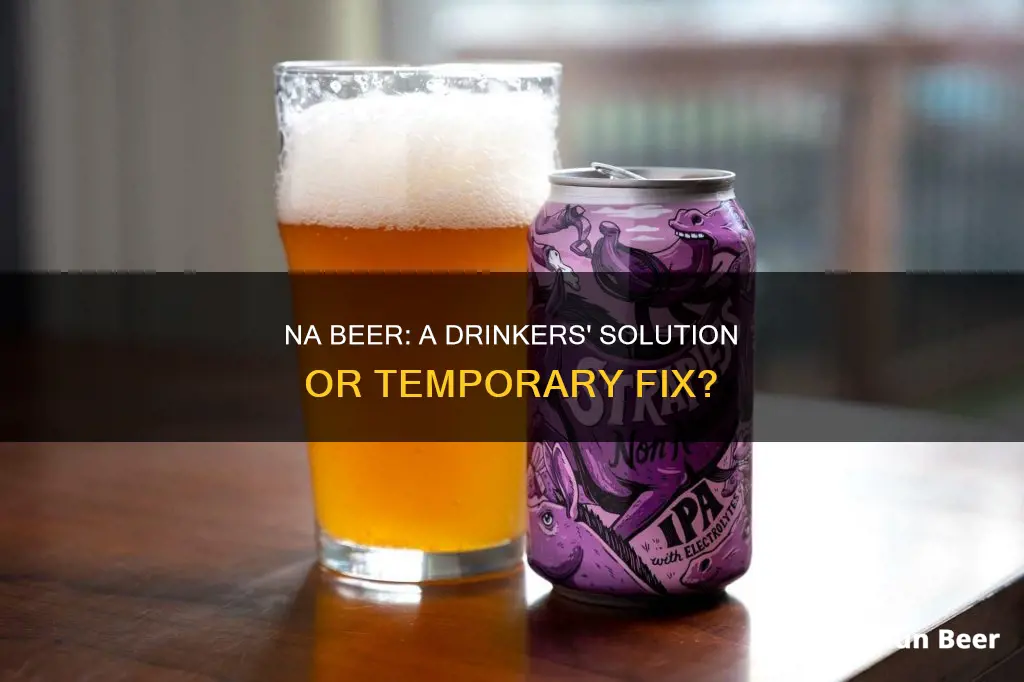
Non-alcoholic beer is often marketed as a safe alternative to alcoholic drinks, but it's important to be aware of the potential risks. While non-alcoholic drinks can be helpful for those looking to reduce their alcohol intake, they can also pose dangers for those with alcohol problems or who are pregnant.
The pros of non-alcoholic beer include the ability to occasionally enjoy a drink while still maintaining sobriety as a goal, and the ability to blend in with peers in social situations without compromising sobriety. It can also be a path to ultimate sobriety for those who find the idea of never drinking again too daunting.
However, the cons include the potential for non-alcoholic beer to trigger cravings and a subsequent relapse, especially for those with alcohol use disorder. The smell, taste, and sensation of non-alcoholic beer can be enough to stimulate the reward centres of the brain and release dopamine. Additionally, non-alcoholic beer may still contain small amounts of alcohol, which can be dangerous for those who need to avoid it completely.
The effectiveness of non-alcoholic beer as a tool to quit drinking is subjective and depends on the individual's unique situation and relationship with alcohol.
| Characteristics | Values |
|---|---|
| Alcohol Content | Non-alcoholic beer is defined as containing 0.5% or less of alcohol by volume (ABV). |
| History | The concept of non-alcoholic beverages was born during Prohibition, a 13-year period (from 1920 to 1933) when the manufacturing, importation, transport, and sale of alcoholic beverages were prohibited in the US. |
| Manufacturing Process | There are four basic methods used to create non-alcoholic beer: controlled fermentation, dealcoholization, dilution, and simulated fermentation. |
| Pros | Non-alcoholic beer can help individuals moderate their alcohol intake without committing to total abstinence. It can also help recovering alcoholics feel included in social situations and provide a path to ultimate sobriety. |
| Cons | The smell and taste of non-alcoholic beer may trigger a relapse in recovering alcoholics. It may also lead to a "placebo effect" of intoxication, causing a dangerous craving for more. |
What You'll Learn

Non-alcoholic beer may still contain alcohol
Non-alcoholic beer is often marketed as a safe alternative to alcoholic beer, and it can be a good option for people looking to reduce their alcohol intake. However, it's important to be aware that non-alcoholic beer may still contain small amounts of alcohol.
By law, non-alcoholic beers can contain up to 0.5% alcohol by volume (ABV). While this is a very small amount, it's important to note that some products labelled as 0.0% ABV have been found to contain alcohol. In fact, one study showed that 29% of no- or low-alcohol beers tested had higher alcohol levels than indicated on their labels, and six beers labelled as 0.0% ABV were found to have alcohol levels higher than 1%.
The reason for this is that non-alcoholic beer is usually produced by removing most of the alcohol from regular beer. However, it is very difficult to remove all traces of alcohol, and some small amounts may remain. Additionally, when the beer is filtered, both water and alcohol are removed, so liquid must be added back in, and this can also introduce small amounts of alcohol.
Because of this, non-alcoholic beer may not be a safe choice for certain groups of people. For example, pregnant women are advised to avoid any alcohol during pregnancy, and non-alcoholic beer may still contain enough alcohol to pose a risk to the developing fetus. Similarly, people with a history of alcohol use problems may find that the smell and taste of non-alcoholic beer trigger cravings and increase the risk of relapse.
In conclusion, while non-alcoholic beer is a good option for some people, it's important to be aware that it may still contain small amounts of alcohol, and this can pose a risk for certain populations. It's always important to check labels and be aware of the potential risks before consuming non-alcoholic beer or any other type of alcoholic beverage.
Hopsy Beer: How Does the Freshness Work?
You may want to see also

It could trigger cravings and cause a relapse
Non-alcoholic beer is often presented as a safe alternative to regular beer, but it can be a trigger for people with alcohol use disorder. The smell and taste of non-alcoholic beer are very similar to regular beer, and this can be a powerful trigger for people trying to quit drinking.
Research has shown that the smell of beer alone may be enough to trigger cravings and a subsequent relapse among certain people with alcohol use disorder. In a study conducted by a team of California scientists, rats were trained to self-administer alcohol when they smelled a particular odour. The researchers found increases in dopamine in the rats' brains before and after smelling these "alcohol-related cues". While this was an animal study, the results suggest that similar effects could occur in humans.
As many as 90% of people with alcohol use disorder will experience at least one relapse within four years of quitting drinking. For people in recovery, even the sound of cracking open a can, the aroma of a fresh beer, or the feel of a cold glass in their hand can stimulate the reward centres of the brain to release dopamine. This can trigger cravings for alcohol and lead to a relapse.
The idea of never being able to drink alcohol again can be daunting for some people, and non-alcoholic beer may seem like a good alternative. However, it is important to consider the potential risks. For people with alcohol use disorder, even small amounts of alcohol can be dangerous. The sensation of drinking beer, even if it is non-alcoholic, can be enough to trigger cravings and cause a relapse.
For some people, non-alcoholic beer may provide a valuable stepping stone to sobriety. It can help them gradually reduce their alcohol intake and address their addiction. However, it is crucial for individuals to be honest with themselves about their ability to control their drinking. If non-alcoholic beer triggers cravings or makes it difficult to maintain sobriety, it is important to avoid it.
Bottoms Up Beer: How Does This Novelty Work?
You may want to see also

It may be beneficial for those who want to cut down their alcohol consumption
Non-alcoholic beer is often marketed as a safe alternative to alcoholic drinks, and it may be beneficial for those who want to cut down their alcohol consumption. However, it is important to be aware of the potential risks involved.
One of the main advantages of non-alcoholic beer is that it allows people to reduce their alcohol intake gradually. This can be especially helpful for those who are not ready or able to commit to complete abstinence. By providing a similar sensory experience to drinking alcohol, non-alcoholic beer can make the transition to sobriety more manageable. It can also help individuals avoid feelings of isolation and exclusion in social situations where alcohol is typically consumed.
Another benefit of non-alcoholic beer is that it often contains fewer calories and has more wholesome ingredients than its alcoholic counterpart. It can be a healthier alternative for those looking to improve their physical health without giving up the ritual of drinking. Additionally, non-alcoholic beer can help individuals address their addiction by providing a space to restrict their drinking gradually.
However, it is important to note that non-alcoholic beer still contains a small amount of alcohol, typically up to 0.5% ABV. This means that consuming a large quantity of non-alcoholic beer can still lead to intoxication. Additionally, the smell and taste of non-alcoholic beer may trigger cravings and increase the risk of relapse for those in recovery from alcohol use disorder. For these individuals, it is crucial to avoid any triggers that may lead back to detrimental drinking habits.
While non-alcoholic beer can be a helpful tool for some, it is not a one-size-fits-all solution. Each person must evaluate their own situation and decide if the benefits of non-alcoholic beer outweigh the potential risks. For some, the dangers may be too significant, and complete abstinence may be the best course of action. Ultimately, the decision to consume non-alcoholic beer during recovery is a personal one that should be made with careful consideration and, ideally, under the guidance of a healthcare professional.
Low-Carb Diet and Beer: Is It Possible?
You may want to see also

It can be a good way to start drinking less
Drinking non-alcoholic beer can be a good way to start drinking less. Firstly, it is important to understand your relationship with alcohol and your reasons for wanting to cut down. For example, you might be concerned about your health, or perhaps you feel that you're drinking too much or too often. By examining your drinking habits and setting a drinking goal, you can start to make positive changes.
One benefit of non-alcoholic beer is that it allows you to still enjoy the sensation and experience of drinking, without the negative consequences of alcohol. This can be especially helpful for those who are not ready or willing to commit to total abstinence. It provides a way to moderate alcohol intake while still enjoying social situations that involve drinking. Non-alcoholic beer can help you feel included and reduce the feeling of isolation that can come with abstaining from alcohol.
Additionally, non-alcoholic beer is often made from natural ingredients and has fewer calories than its alcoholic counterpart, promoting a healthier lifestyle. It also has a very low alcohol concentration, making it virtually impossible to get drunk. This can be beneficial for those who want to reduce their alcohol intake gradually.
However, it is important to note that non-alcoholic beer is not completely alcohol-free and can still contain up to 0.5% alcohol by volume. This can be a concern for those who are trying to avoid alcohol entirely or who are sensitive to even small amounts of alcohol. In some cases, the smell and taste of non-alcoholic beer may trigger cravings or a relapse for those in recovery from alcohol use disorder. Therefore, it is crucial to assess your own situation and decide if the benefits of non-alcoholic beer outweigh the potential risks.
If you choose to incorporate non-alcoholic beer into your drinking reduction plan, it is recommended to be persistent and consistent. Cutting down on drinking may not always be easy, and setbacks are normal. It is also important to have social support and to make lifestyle changes that promote sobriety and a healthy relationship with alcohol.
Vaccinated and Thirsty: Beer and COVID Vaccine Timing
You may want to see also

It might not be a good idea for those who are pregnant or trying to conceive
While non-alcoholic beer might be a tempting option during pregnancy, it's important to note that these drinks can still contain up to 0.5% alcohol by volume. This small amount of alcohol can have harmful effects on fetal development, leading to physical, cognitive, and behavioral complications.
The American College of Obstetrics and Gynecology (ACOG) states that there is no known safe amount of alcohol intake during pregnancy. Alcohol consumption during pregnancy is linked to behavioral and learning difficulties, birth defects, and fetal alcohol spectrum disorder (FASD). FASD can cause dysmorphic facial features, growth retardation, and serious neurodevelopmental disorders. Therefore, ACOG recommends that pregnant individuals avoid drinking any alcohol during pregnancy to eliminate the risk of FASD.
Furthermore, research suggests that non-alcoholic beers often contain more alcohol than their labels indicate. A study found that 29% of no- or low-alcohol-content beers tested had higher alcohol levels than advertised. Of the zero-alcohol beers sampled, 6 were found to have alcohol levels higher than one percent, with some even reaching 1.8%. As there is no known safe threshold for alcohol intake during pregnancy, consuming these beverages could potentially harm the developing fetus.
Additionally, the smell of non-alcoholic beer, which is very similar to regular beer, may serve as a trigger for individuals with a history of alcohol use problems. The anticipation of alcohol may raise levels of dopamine, a brain chemical associated with feelings of elation and pleasure. This can increase the risk of relapse for individuals in recovery from alcohol use disorder.
For these reasons, it is generally recommended that pregnant individuals or those trying to conceive avoid consuming non-alcoholic beers. While it may be challenging to give up this beverage, it is crucial to prioritize the health and well-being of both the mother and the unborn child. Alternatives such as alcohol-free mocktails or drinks labeled "alcohol-free" can be safer options to satisfy cravings without risking exposure to alcohol.
Mixing Beer and Cough Medicine: Is It Safe?
You may want to see also
Frequently asked questions
Non-alcoholic beer can be a helpful tool for those looking to quit drinking, but it may not be effective for everyone. While it can provide a sense of familiarity and ritual, it may also trigger cravings and relapse for some people. It is important to be aware of the potential risks and benefits of NA beer before incorporating it into your recovery plan.
NA beer can provide a sense of familiarity and ritual for those quitting drinking. It can help individuals feel included in social situations where alcohol is present without compromising their sobriety. Additionally, NA beer often contains fewer preservatives and added sugars than regular beer, making it a healthier alternative.
One of the main risks of using NA beer to quit drinking is the potential for triggering cravings and relapse. The smell, taste, and sensation of NA beer can stimulate the reward centres of the brain and release dopamine, which may lead to a desire for full-strength alcoholic beverages. Additionally, some NA beers may contain higher levels of alcohol than indicated on their labels, which can be dangerous for individuals in recovery.







